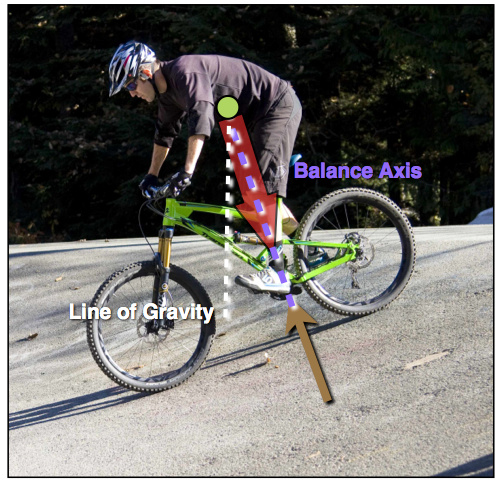Stories posted under Pinkbike Community blogs are not edited, vetted, or approved by the Pinkbike editorial team. These are stories from Pinkbike users.
If a blog post is offensive or violates the Terms of Services, please report the blog to Community moderators.
THE BALANCE AXIS... tipping "down" the hill, to stay centred.
THE BALANCE AXIS
Understanding what Balance Axis is and why this is important, is key to understanding the physics behind why riders stay centred on their bikes when descending, instead of moving back. The Balance Axis is basically an imaginary line from the rider’s Centre of Mass (COM - green circle) through the middle of the Base of Support (BOS); on the bike, this point is slightly in front of the bottom bracket. Whether a rider’s Balance Axis remains vertical or “tips” down hill (to become more perpendicular to the surface of the slope), depends on if a rider is moving with or resisting gravity.
How rider changes from being vertical to perpendicular, is controlled by their body position over the bike... they keep their chin over the stem to stay centred (giving a perpendicular Balance Axis), or move back (giving a vertical Balance Axis).
Here you can see some of the forces involved, while moving down a slope.
- Gravity creates an Applied Force (red arrow) from the rider as his weight pushes down on the ground.
- The ground then creates an equal and opposite force, called the Ground Reaction (GR) Force (brown arrow).
- Without this force, the rider would fall through the ground.
- On a slope, when a rider is coasting (with little to no brakes applied), both these forces are perpendicular to the terrain surface.
- If the rider where stationary on the slope or there was friction (the brakes were significantly applied), these forces would be more, if not totally, vertical.
For a rider to be stable, they must be in a position in which they are balanced against any forces acting on them. In a technical sense, this means any forces acting on them, must do so through their centre of mass (COM) and through the middle of their Base of Support (BOS).
Because both the Applied and Ground Reaction forces are perpendicular to the terrain surface, if the rider wants to be stable, he needs to line up his COM in a position over the bike, so that if you draw a straight line from the COM through the middle of the BOS, it too will be perpendicular. The rider achieves this by "tipping" down the hill, keeping his chin over the stem and we call this "line" the Balance Axis.
On a horizontal surface (flat), the Ground Reaction Force is straight up - vertical. Therefore, to be stable and balanced, the rider would ensure his Balance Axis is also vertical. The rider does this by again, keeping his chin over the stem and hips above the feet.
However, if the rider's Balance Axis was vertical on a slope (his chin was behind the stem and his weight over the rear wheel), the brown arrow (Ground Reaction force) would push the rider backwards by exerting a force outside of his centre of mass, making the rider unstable. In other words, the rider's centre of mass is not aligned against the forces acting on it. The rider would also have very little weight on the front wheel, reducing front end traction and have limited range of movement, since his arms are almost straight. As such, you can often tell a rider is centred by noticing their chin is over the stem (or at least close to this) and their elbows are bent.
DISCLAIMER: This is a rather simplified version of all the physics involved in an object moving down a slope... in this case, a mountain biker. As such, with any simplification there is obviously some information missing. However, for the purposes of giving an insight into some of the physics behind staying centred on a bike, while coasting on a descent, this short blog hopefully serves it's purpose.
For more info, check out our ZEP Mythbusters "How-to" blogs on Position for Descending & Cornering and Position for Steeps & Heavy Braking.
Cheers,
Paul
About the Author
Paul Howard is the Owner-Director and Head Coach of ZEPtechniques, Technical Director of the Professional Mountain Bike Instructor Association, Head Snowboard Trainer for Whistler Blackcomb SnowSchool, Technical Education Committee and 2015 Interski Team Member for the Canadian Association of Snowboard Instructors, and has been teaching mountain biking and training mountain bike instructors around the world, since the late 90's.
About ZEP
ZEPtechniques is a Whistler-based mountain bike camps and instructor training company. Established in 2006, ZEP offers single and multi-week, adult specific rider improvement camps, as well as weekly clinics, private lessons and tours. ZEP's Instructor Training services include the industry's original, multi-week mountain bike instructor training camps; training riders four days per week with evening seminars on suspension set up, bike mechanics, nutrition, as well as strength and conditioning sessions, all with industry experts. As developers of the internationally available Professional Mountain Bike Instructor (PMBI) Certifications and Directors of the PMBI Association, ZEP has long played a key role in establishing and improving the finest teaching practices and instructor certifications, within mountain biking.
ZEP is proudly supported by
Transition Bikes
ANVL Components
Fox Racing Shox
Troy Lee Designs
Five Ten
MRP
EVOC
Evolution Whistler
Vorsprung Suspension
Reel Cameras
Spun Studios
Starlight Custom Apparel
Understanding what Balance Axis is and why this is important, is key to understanding the physics behind why riders stay centred on their bikes when descending, instead of moving back. The Balance Axis is basically an imaginary line from the rider’s Centre of Mass (COM - green circle) through the middle of the Base of Support (BOS); on the bike, this point is slightly in front of the bottom bracket. Whether a rider’s Balance Axis remains vertical or “tips” down hill (to become more perpendicular to the surface of the slope), depends on if a rider is moving with or resisting gravity.
How rider changes from being vertical to perpendicular, is controlled by their body position over the bike... they keep their chin over the stem to stay centred (giving a perpendicular Balance Axis), or move back (giving a vertical Balance Axis).
Here you can see some of the forces involved, while moving down a slope.
- Gravity creates an Applied Force (red arrow) from the rider as his weight pushes down on the ground.
- The ground then creates an equal and opposite force, called the Ground Reaction (GR) Force (brown arrow).
- Without this force, the rider would fall through the ground.
- On a slope, when a rider is coasting (with little to no brakes applied), both these forces are perpendicular to the terrain surface.
- If the rider where stationary on the slope or there was friction (the brakes were significantly applied), these forces would be more, if not totally, vertical.
For a rider to be stable, they must be in a position in which they are balanced against any forces acting on them. In a technical sense, this means any forces acting on them, must do so through their centre of mass (COM) and through the middle of their Base of Support (BOS).
Because both the Applied and Ground Reaction forces are perpendicular to the terrain surface, if the rider wants to be stable, he needs to line up his COM in a position over the bike, so that if you draw a straight line from the COM through the middle of the BOS, it too will be perpendicular. The rider achieves this by "tipping" down the hill, keeping his chin over the stem and we call this "line" the Balance Axis.
On a horizontal surface (flat), the Ground Reaction Force is straight up - vertical. Therefore, to be stable and balanced, the rider would ensure his Balance Axis is also vertical. The rider does this by again, keeping his chin over the stem and hips above the feet.
However, if the rider's Balance Axis was vertical on a slope (his chin was behind the stem and his weight over the rear wheel), the brown arrow (Ground Reaction force) would push the rider backwards by exerting a force outside of his centre of mass, making the rider unstable. In other words, the rider's centre of mass is not aligned against the forces acting on it. The rider would also have very little weight on the front wheel, reducing front end traction and have limited range of movement, since his arms are almost straight. As such, you can often tell a rider is centred by noticing their chin is over the stem (or at least close to this) and their elbows are bent.
DISCLAIMER: This is a rather simplified version of all the physics involved in an object moving down a slope... in this case, a mountain biker. As such, with any simplification there is obviously some information missing. However, for the purposes of giving an insight into some of the physics behind staying centred on a bike, while coasting on a descent, this short blog hopefully serves it's purpose.
For more info, check out our ZEP Mythbusters "How-to" blogs on Position for Descending & Cornering and Position for Steeps & Heavy Braking.
Cheers,
Paul
About the Author
Paul Howard is the Owner-Director and Head Coach of ZEPtechniques, Technical Director of the Professional Mountain Bike Instructor Association, Head Snowboard Trainer for Whistler Blackcomb SnowSchool, Technical Education Committee and 2015 Interski Team Member for the Canadian Association of Snowboard Instructors, and has been teaching mountain biking and training mountain bike instructors around the world, since the late 90's.
About ZEP
ZEPtechniques is a Whistler-based mountain bike camps and instructor training company. Established in 2006, ZEP offers single and multi-week, adult specific rider improvement camps, as well as weekly clinics, private lessons and tours. ZEP's Instructor Training services include the industry's original, multi-week mountain bike instructor training camps; training riders four days per week with evening seminars on suspension set up, bike mechanics, nutrition, as well as strength and conditioning sessions, all with industry experts. As developers of the internationally available Professional Mountain Bike Instructor (PMBI) Certifications and Directors of the PMBI Association, ZEP has long played a key role in establishing and improving the finest teaching practices and instructor certifications, within mountain biking.
ZEP is proudly supported by
Transition Bikes
ANVL Components
Fox Racing Shox
Troy Lee Designs
Five Ten
MRP
EVOC
Evolution Whistler
Vorsprung Suspension
Reel Cameras
Spun Studios
Starlight Custom Apparel
Author Info:
Must Read This Week
[UPDATED] Final Elite XC Results & Overall Standings from the Mairiporã XC World Cup 2024
42198 views
42198 views
Sign Up for the Pinkbike Newsletter - All the Biggest, Most Interesting Stories in your Inbox
PB Newsletter Signup



 Member since Mar 24, 2006
Member since Mar 24, 2006
www.tulane.edu/~sanelson/Natural_Disasters/slopestability.htm
In a nutshell, Gravity on a slope can be resolved into two components... one that keeps the object on the ground and one that pulls the object down the slope. Similarly, the opposing Ground Reaction force is also a sum of different components. Either way, keeping the COM vertically above the BB will make the rider unbalanced, if they are coasting (no brakes are on). And you can feel and see this in your own rider. The fact that you have your chin over the stem when you are coasting down a hill, is you doing exactly this.